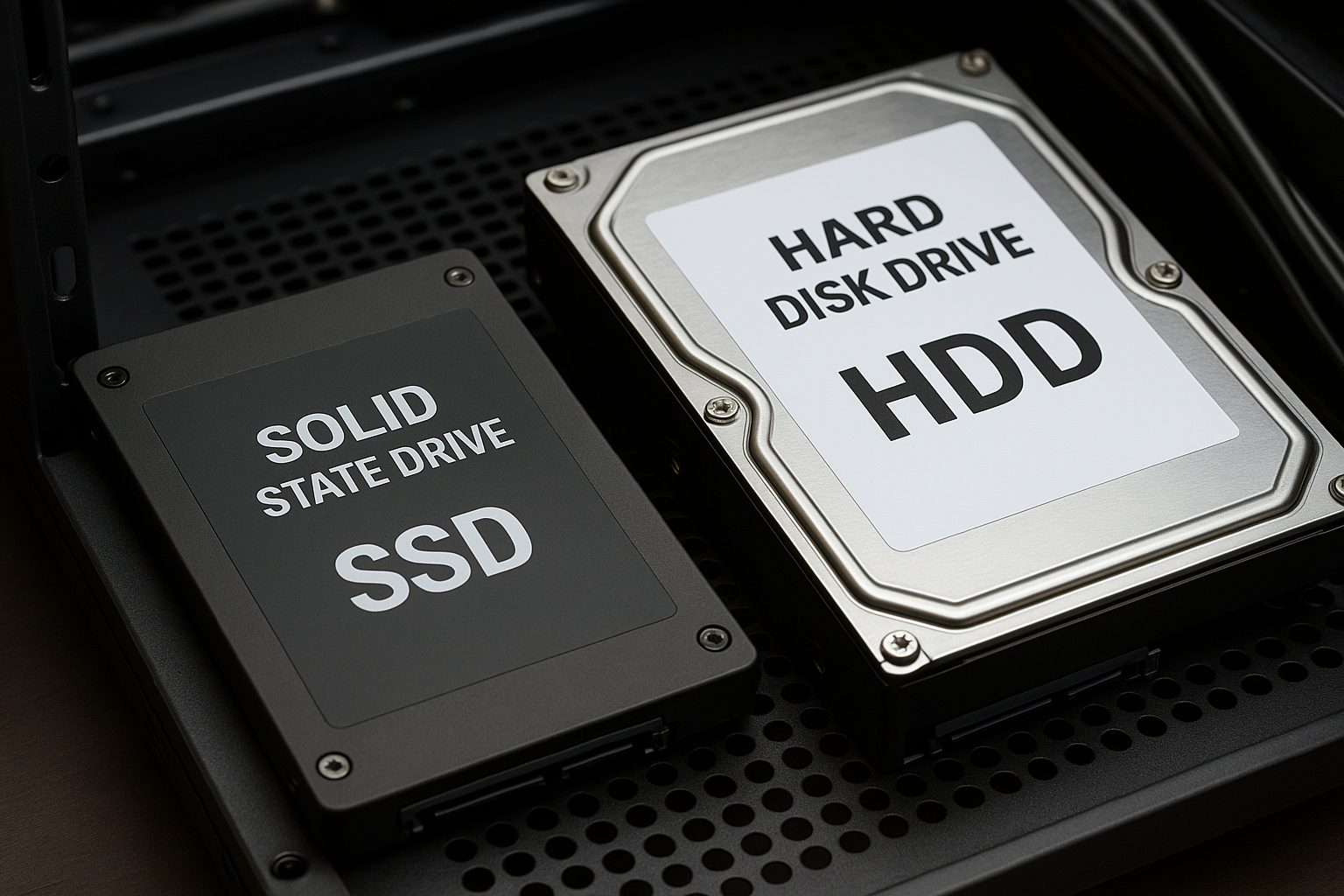When building a computer from scratch, choosing the right storage device is a crucial decision. The two main types of storage drives — SSD (Solid State Drive) and HDD (Hard Disk Drive) — each have their strengths, weaknesses, and ideal use cases. Understanding their differences will help you make the best choice based on your performance expectations, budget, and long-term needs.
What Is an HDD?
An HDD, or Hard Disk Drive, is a traditional storage device that has been around for decades. It uses spinning magnetic disks to read and write data, similar to how vinyl records work.
Key Characteristics:
- Mechanical parts: Includes a spinning disk (platter) and a moving read/write arm.
- Data stored magnetically: Information is written on the surface of the platter.
- Noise and heat: Because it involves moving parts, it can be noisier and generate more heat.
Advantages of HDDs:
- Cheaper per gigabyte: Great for storing large volumes of data like videos, backups, and documents.
- High capacity: Commonly available in sizes ranging from 1TB to 10TB or more.
- Long-term availability: Mature technology with wide compatibility.
Disadvantages:
- Slower read/write speeds: Boot times and file loading are significantly slower compared to SSDs.
- More prone to damage: Moving parts mean higher risk of physical failure if dropped or bumped.
- Heavier and bulkier: Not ideal for ultra-thin laptops or compact PC builds.
What Is an SSD?
An SSD, or Solid State Drive, is a newer type of storage that uses flash memory (like a USB stick) to store data.
Key Characteristics:
- No moving parts: Data is stored on interconnected flash memory chips.
- Silent operation: No spinning or clicking noises.
- Lower power usage: Ideal for laptops and energy-efficient setups.
Advantages of SSDs:
- Much faster: Boot time, app loading, and file transfer speeds are significantly faster than HDDs.
- More reliable: No mechanical parts make them more durable and shock-resistant.
- Compact size: Available in small form factors like M.2 and NVMe drives.
Disadvantages:
- More expensive per GB: Higher cost for the same storage size compared to HDDs.
- Limited write cycles: Although technology has improved, SSDs have a finite number of write cycles.
- Lower capacities at affordable prices: Large SSDs (2TB or more) are still costly for many users.
Speed Comparison: SSD vs. HDD
Speed is where SSDs clearly dominate:
- Boot Time:
- HDD: 30-60 seconds
- SSD: 10-20 seconds
- File Transfer:
- HDD: Up to 150 MB/s
- SSD (SATA): Around 500 MB/s
- SSD (NVMe): Up to 7000 MB/s (or higher)
If you’re building a PC and want a responsive system, an SSD is almost always the better choice for the operating system and apps.
Storage Options: Combining SSD and HDD
Many users combine both types of drives for the best of both worlds:
- SSD (primary): Install the operating system and frequently used applications.
- HDD (secondary): Use for storing large files, backups, games, videos, and documents.
This hybrid setup balances performance and storage capacity, especially if you’re on a budget.
Longevity and Reliability
HDD:
- Lifespan depends on mechanical wear.
- Susceptible to physical damage.
- Useful for long-term archiving if kept in safe environments.
SSD:
- Resistant to shock and vibration.
- May degrade over time due to limited write cycles.
- Better for daily, heavy use due to speed and reliability.
Price Considerations
As of now, the cost per gigabyte remains a deciding factor:
- HDDs: Around $0.03 to $0.05 per GB
- SSDs: Around $0.07 to $0.15 per GB (SATA) or more for NVMe
If you’re building a budget PC and need lots of storage, an HDD can save money. But if speed is a priority, it’s worth investing in an SSD — even if it’s just 256GB or 512GB to start.
Ideal Use Cases
Choose an HDD if:
- You need lots of cheap storage (e.g., 2TB+)
- You’re building a file server or media center
- Your usage is mostly light or involves archived content
Choose an SSD if:
- You want fast boot times and quick program loading
- You’re building a gaming or productivity PC
- You’re using the system daily for multiple tasks
NVMe vs SATA SSDs
If you decide to go with an SSD, you’ll need to choose between SATA and NVMe:
- SATA SSDs: Use the same connection as traditional HDDs. They’re much faster than HDDs but slower than NVMe SSDs.
- NVMe SSDs: Connect via PCIe lanes, offering much higher data transfer speeds and lower latency. Ideal for gaming, video editing, and demanding tasks.
Final Thoughts: Which One Should You Choose?
In most modern PC builds, especially if you’re prioritizing speed and efficiency, an SSD is essential — at least for your operating system and main programs.
However, HDDs still have value, especially for mass storage at lower cost. Many users opt for a dual-drive setup, which provides performance where it matters and space where it counts.
Your choice ultimately depends on your budget, performance needs, and storage goals. But one thing is certain: understanding the differences helps you avoid bottlenecks and build a PC that’s efficient, reliable, and tailored to your use.
